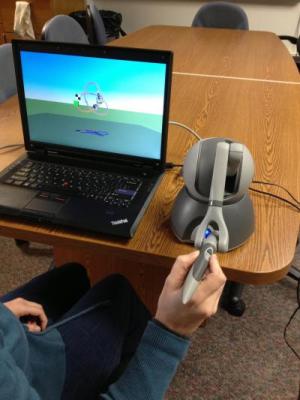Nov 27 2012
An Indiana University study in the Journal of Child Neurology proposes an innovative treatment for developmental coordination disorder, a potentially debilitating neurological disorder in which the development of a child's fine or gross motor skills, or both, is impaired.
 This device enables children with DCD to improve their fine motor skills by tracing a virtual three-dimensional path. Credit: Indiana University
This device enables children with DCD to improve their fine motor skills by tracing a virtual three-dimensional path. Credit: Indiana University
DCD strikes about one in 20 children, predominantly boys, and frequently occurs alongside ADHD, autism spectrum disorders and other better known conditions. Like ADHD, DCD has broad academic, social and emotional impact. It can severely affect reading, spelling and handwriting abilities; and insofar as children with DCD both struggle with and avoid physical activity, it can also lead to problems with self-esteem, obesity and injury.
Severity of the disorder varies, and as the researchers explain, it is sometimes called the "hidden disorder" because of the way those with milder cases develop coping strategies that conceal the disorder, such as using computers to avoid handwriting tasks, and wearing shirts without buttons, or shoes without laces. But children with DCD have been generally thought unable to learn or improve their motor skills.
"The results of this study were remarkable," said lead author Geoffrey Bingham, professor in the Department of Psychological and Brain Sciences in the College of Arts and Sciences. "After training the children over a five- to six-week period, one day a week for 20 minutes at a time, the differences between children with DCD and typically developing children were all but obliterated."
Key to the training was a unique technology: a three-dimensional virtual reality device, the PHANTOM Omni from Sensable Technologies, developed for the visualization of knots by topologists, who study geometric forms in space. Holding a stylus attached to a robot, participants in the study developed their fine motor skills by playing a game in which they traced a three-dimensional virtual path in the air, visually represented on a computer screen. Forces such as magnetic attraction and friction can be applied to the path and adjusted so participants could actually feel a surface that changed as the parameters were altered.
The study compared the progress of a group of eight 7- to 8-year-olds with DCD to a group of eight 7- to 8-year-old typically developing children in a three-dimensional tracing game. The task was to push a brightly colored fish along a visible path on a computer screen from the starting location to the finish point while racing a competitor fish.
The training started with the highest level of magnetic attraction, slowest competitor and shortest path. The goal of the training was to allow the children to progress at their own pace through the different combinations and levels of attraction, paths and competitors.
THE CHILDREN'S 'CATCH-22'
As Bingham's collaborator Winona Snapp-Childs, a post-doctoral fellow in the Department of Psychological and Brain Sciences, explains, the particular challenge facing children with DCD is a "Catch-22" situation. Children must first be able to approximate a movement by actively generating it themselves before they can improve it through practice and repetition. But because children with DCD have been unable to produce this initial movement, they have been unable to improve their skills.
The technology provided the tool needed to overcome this impasse. It gave both the support needed to produce the movement, as well as the flexibility to let children actively generate the movement themselves. It allowed the children to do what they otherwise could not do: produce the requisite initial movements that could then be practiced to yield quantitative improvements.
The researchers say the technology could potentially be widely accessible: It can be used without a therapist and is portable enough to be put in clinics, classrooms or the home. It can also be adjusted to suit the needs of children across the spectrum of DCD severity.